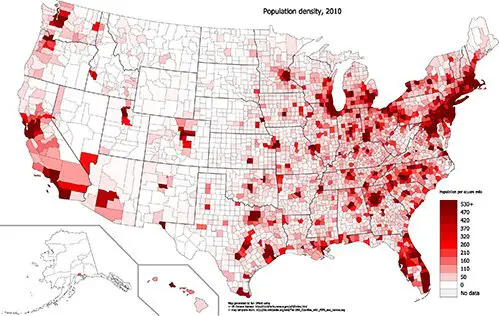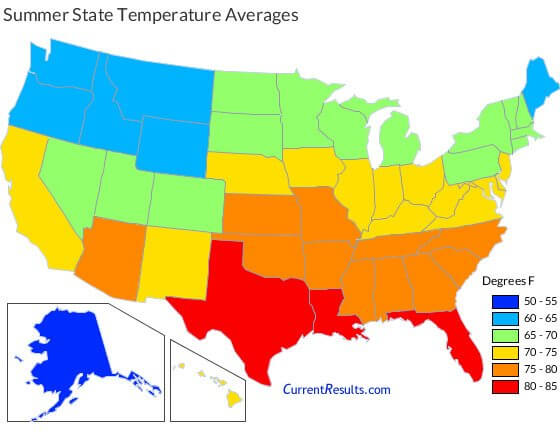Americans have some of the best bug-out locations in the world. It gets even better when you factor in the relative ease of acquiring weapons and the ability to move freely from state to state.
The best bug-out locations in America are the pacific northwest, the Appalachian mountains, much of the central plains states, Arkansas, Mississippi, Alabama, and southern Georgia.
What is a Bug Out Location
People have many different ideas of what a bug-out location should be. For some, it’s a relative’s house that lives outside the city. For others, it’s a fully loaded retreat in the woods with enough supplies to last 100 years.
All bug-out locations have something in common. They are a place that is located away from your home that you can go to if your home becomes uninhabitable for some reason.
Why Bug Out?
We discuss some reasons to bug out at length in other articles. For our purposes here, it can be anything. A natural disaster, a man-made disaster, or anything else.
When something happens that makes it impossible or too dangerous to stay in your house, it’s time to bug out. Even though this article is all about bug-out locations, you shouldn’t be bugging out as your first plan. Under almost any circumstance, bugging in is the better choice!
Is it better to bug in or bug out?
Bugging out requires a lot of preplanning for it to be a good idea. It also means leaving most of your things behind and putting you into situations that aren’t always easy to predict. Even great bug-out plans can lead to disaster if things don’t turn out as planned!
This is why bugging in is such a good idea. You have your supplies in your house, a warm place to sleep, and your friends and family know where you are! Don’t underestimate the power of staying put.
What should you look for in a good bug-out location?
Ideally, you will want to go somewhere with a low population that can support you and your family. This means trees, wildlife, water, and shelter.
The weather is important as well. Moderate weather throughout the year is excellent if you can find it. If an area typically has seasons with extreme weather like tornados, floods, or draughts, then you’re better off selecting somewhere else.
Mild winters and summers are ideal. Long growing seasons and not having extreme temperatures are a big plus.
It would be best if you also considered defensibility when making your decision. This isn’t related to the part of the country as much as it is to the particular terrain in the area you want to bug out to.
Does the area stand out on the landscape, or is it hidden? Either way will work, but if you can be seen from the road, you may have to deal with people looking for a place to stay or supplies. Make sure you have a plan if people are likely to see you from a distance and stop in unannounced.
Is the area close enough to where you live for you to get there in the event of a disaster? When the time to bug outcomes, you’ll want to get to safety relatively quickly.
Anything more than a couple of hours is too much for me. You will have to decide how long that time is for you and your family.
Are there alternate ways to get there if the roads are full of traffic? Are there train tracks that you could use to access the area? Are there powerlines nearby that may have the right of way cleared under them?
Thinking outside the box is key when you’re in a disaster situation. Look up maps of the area online and note any natural or man-made routes you could use for travel.
Do you need a vehicle to get there? What happens if your vehicle breaks down or can’t be used for one reason or another? If you’re a three-hour drive away, what happens if you need to walk that distance?
These are all things that we need to plan for ahead of time. A solid bug-out bag will be key if you need to take the family on a multi-day march!

Which Areas Are The Best?
We want to stay away from large population centers, which rule out much of the northeastern coastline, most of Florida, and much of California. It also rules out major cities like Chicago, Atlanta, and the Dallas-Fort Worth area.
Looking at this map, we can see the average summer temperatures for each state. If we want to stay out of the hottest areas of the U.S., we will have to avoid Florida, Louisiana, and Texas.
Other areas to avoid are the southwestern U.S. which has vast amounts of desert and little water.

Places to Look at First for a Bug Out Location
Some of the best areas to bug out:
The pacific northwest typically has decent vegetation, animals, and natural water supplies.
The Appalachian mountains are another area that would be good.
Much of the central plains states are also a good choice.
Arkansas, Mississippi, Alabama, and southern Georgia would also be high on my list.
Keep in mind that this is just a rough look at the country. For the most part, you’ll be able to find a good place to call your bug-out location in any area.
How far should your bug-out location be?
Choosing how far away your bug-out location should be will depend on a few things.
If you’re bugging out to get away from a city or other population area, you need to move far enough away that the people in that area aren’t likely to go to the area you’re bugging out to. If you live close to a military installation, it would probably be a good idea to have a bug-out location far enough away so you wouldn’t be affected by any potential attacks on the installation.
Overall, your goal should be a bug-out location at least a couple of hundred miles from major population centers and military installations. It also needs to be far enough away from the original location that you wouldn’t be affected by whatever caused you to bug out in the first place!
Living Off the Grid
Are you going to be living off-grid at your bug-out location? For a lot of people, the answer is going to be yes. Even if you aren’t planning to live without power at your bug-out location, there’s a good chance you may not have the power there when you get there.
Are you prepared to deal with not having access to power? This means you will have to plan for things like generators and solar panels.
What states is it legal to live off the grid?
Technically, it isn’t illegal to live off the grid in any state. Living off-grid means you will not use or rely on power produced from the grid. There’s nothing wrong with that.
When you start building things like greenhouses, gardens, chicken coops, and putting up solar panels, you start to get into different legalities and local ordinances. Of course, this doesn’t matter much in a disaster, but if you plan to build up your bug out of the location beforehand, you could run into issues.
What is the best state to live off the grid?
Choosing the best state to live off-grid is just about as cut and dry as choosing the perfect bug-out location…it isn’t.
We chose this list of states based on these factors:
- Land Prices
- Taxes
- Population Density
- Zoning Laws
- Political Climate
These are the best states to live off-grid:
- Tennesee
- Texas
- Montana
- Missouri
- North Carolina
- Arizona
- Ohio
- Vermont
- Maine
- Oregon
Can You Keep a Bug Out Cache at the Location
Bug-out caches are a store of supplies you can place on the way to your bug-out location and in place at your bug-out location. They allow you to travel lighter and have
A bug-out cache is another thing to consider when choosing a bug-out location. Is it possible to keep a cache at your chosen bug-out location without it being stolen?
If you can safely store supplies in your bug-out location, getting back on your feet is much easier when you get there.
Another option is to bury or hide supplies there if you don’t have an area to lock up. This is great if you plan to bug out to an area that you don’t own or an area on public land. Bugging out to areas you don’t control isn’t the best plan, but hiding a cache of supplies can make it possible as long as others don’t get there before you.
What should be included in a survival cache at your bug-out location?
When you build out your bug-out location cache, you should include the items you need or things that will be too heavy to carry with you. Food, water, warm clothing, extra batteries, and weapons are all good choices, but you will have to choose based on your specific scenario and your family’s needs.
Some items to include in a survival cache are:
- Food
- Water
- Water Filter
- Firestarter
- Flashlight and Batteries
- First Aid Kit
- Warm Clothing
- Tarp
- Knives
- Weapons
Other Considerations
Certain locations have other things to consider as well. For example, if you’re bugging out to the central U.S., you may need to be aware of tornadoes and other extreme weather.
If you live in Utah, prepping is practically a way of life due to the influence of the LDS church. Every place has positive things that could easily outweigh the things we’ve discussed above.
Conclusion
This was just a brief overview of some things you should consider when trying to find the best bug-out location. Many things could make a certain area perfect for you or make an otherwise great place not to work. It all comes down to the needs of you and your family!

